|
|
|
Sort Order |
|
|
|
Items / Page
|
|
|
|
|
|
|
| Srl | Item |
| 1 |
ID:
138968
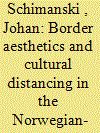

|
|
|
|
|
| Summary/Abstract |
The borderscape is a flexible entity that goes beyond the space of the border and the borderland. This article argues that art and literature can be constitutive elements in the borderscape, along with other kinds of bordering and demarcation. Art and literature can help create resistance through performative acts of “borderscaping”, taking place in different locations and involving different perspectives. The article uses the aesthetic categories of the sublime, the postmodern, and the defamiliarised to trace forms of “distance” or “distancing” as they appear in conceptualisations of the borderscape. Artistic practices in the Norwegian-Russian borderscape are examined in an evaluation of their geopolitical significance, with particular attention given to descriptions of the Norwegian-Russian border in novels by John Fowles and Kjartan Flogstad.
|
|
|
|
|
|
|
|
|
|
|
|
|
|
|
|
| 2 |
ID:
138969
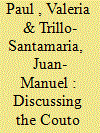

|
|
|
|
|
| Summary/Abstract |
The assumption that the border between Spain and Portugal is a stable one since medieval times is commonplace. Thus, the territorial trap conception, as defined by John Agnew, dominates understanding of this border. This paper will focus on a specific border area, the Couto Mixto, in an effort to contest this territorial trap. Furthermore, using some of the emerging border studies concepts, mainly borderscapes and border poetics, this research will discuss how this particular territory has been recently recovered and recreated. The theoretical underpinnings are followed by an analysis of what the Couto was and how it has been reappropriated in narrative terms in the last twenty years. The paper concludes by discussing the empirical findings on the Couto in light of the theoretical sections. It is eventually suggested that tourism based on specific immaterial border legacy could encourage Couto’s inhabitants and the precarious economy of the area.
|
|
|
|
|
|
|
|
|
|
|
|
|
|
|
|
| 3 |
ID:
138967
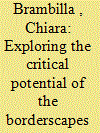

|
|
|
|
|
| Summary/Abstract |
The conceptual evolution of borders has been characterised by important changes in the last twenty years. After the processual shift of the 1990s (from border to bordering), in recent years there has been increasing concern about the need to critically question the current state of the debate on the concept of borders. Within this framework, this article explores the critical potential of the borderscapes concept for the development of alternative approaches to borders along three main axes of reflection that, though interrelated, can be analytically distinguished as: epistemological, ontological and methodological. Such approaches show the significant potential of borderscapes for future advances of critical border studies in the era of globalisation and transnational flows, thereby contributing to the liberation of (geo)political imagination from the burden of the ‘territorialist imperative’ and to the understanding of new forms of belonging and becoming that are worth being investigated.
|
|
|
|
|
|
|
|
|
|
|
|
|
|
|
|
| 4 |
ID:
138971
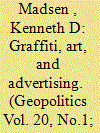

|
|
|
|
|
| Summary/Abstract |
Physical barriers are an increasingly popular political mechanism for central government control over the flows of goods and people at borders. This medium also, however, serves as a canvas for unsanctioned expressions of belonging. Just as graffiti and art are deployed in the urban landscape as unconventional means of claiming space, they are utilised on international border barriers to contest prevalent political winds and re-claim local and alternative senses of who belongs and what is deemed important in debates over border policy. This paper considers unauthorised text and visual imagery on the border barriers of the Arizona-Sonora section of the US-Mexico boundary as a therapeutic reaction to a state-dominated border policy which downplays local impacts. It is argued that such imagery serves to re-scale border space and thereby re-capture a sense of belonging by those whose roles are marginalised by national politics and the neoliberal global economy.
|
|
|
|
|
|
|
|
|
|
|
|
|
|
|
|
| 5 |
ID:
138974
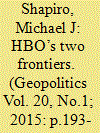

|
|
|
|
|
| Summary/Abstract |
The Wire (five seasons, 2002–2008) takes place in Baltimore, an urban venue that is distinguished by diverse modes of violence and alienation – the colour line, tensions between governmental bureaucracy and citizen, between policing executives and investigators, between corporate-oriented drug dealers and individual (take-no-prisoners) dealers, and in general between aspiring change-agents and entrenched power holders. And most significantly for this analysis, The Wire explores what Robert Crooks identifies as the new “urban frontier.” The older frontier (in “the West”) is depicted in Deadwood (three seasons, 2004–2006). That frontier, as Cronon, Miles, and Gitlin point out, was, at the outset of the Euro American–Native American encounter, a space of negotiation, a space in which institutionalised regionalisation had not yet been installed.
|
|
|
|
|
|
|
|
|
|
|
|
|
|
|
|
| 6 |
ID:
138970


|
|
|
|
|
| Summary/Abstract |
Contemporary world is increasingly marked by borders, fences and walls, which run through the spaces we live in. Borders are the result of a composite articulation of material aspects, concerning their external realisation, and structures of imagination, symbolic constructs and conceptual formations that involve the border and make it meaningful. In this dynamic and mutable field, artistic practices and interventions can interrupt and alterate the logic of the border, opening up a space of resistance and critical imagination, where the transparent, immutable and essentialist representation of the border is constantly challenged. Works of artists such as Bajevic, Hatoum, Salcedo, Rosver and Meredith-Vula will be analysed. They are used to transforming this separation, which they have usually lived personally, in symbolic landscape like interior landscapes. Working on imagination and creating alternative spaces, artists are able to challenge dominant representations and hegemonic discourses, making the border an active site of resistance and struggle.
|
|
|
|
|
|
|
|
|
|
|
|
|
|
|
|
| 7 |
ID:
138972
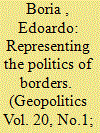

|
|
|
|
|
| Summary/Abstract |
The relationship between cartography and power has aroused much interest in recent years, stimulated by innovative critical approaches. The empiricist and neo-positivist paradigms, no longer satisfactory, have been abandoned, while the analysis has been extended to include not only state-sponsored, but also popular cartography. Regardless of the character of the map or its source, it continues to be inserted in the context of the modern territorial state, as it is perceived as a key instrument for conveying the state’s narrative. Seen in this light, cartography inevitably comes out on the subordinate end of this relationship, since it fully conforms to the orthodox state-centred world view that has dominated modernity. Overturning this mechanically deconstructionist approach, this paper proposes, instead, to apply a concept introduced by John Brian Harley, the father of critical cartography – that of the map’s internal power. This concept, usually considered a given and rarely tested in empirical studies, is evaluated here through an analysis of the border sign in a series of unorthodox maps (in the work of Reclus, Mackinder, Renner, Spykman, Horrabin, Radó, Ratzel, Kjèllen, Haushofer) which have received little scientific attention to date.
|
|
|
|
|
|
|
|
|
|
|
|
|
|
|
|
| 8 |
ID:
138973
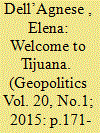

|
|
|
|
|
| Summary/Abstract |
Popular music has not yet been widely considered by popular geopolitics practitioners. This paper develops such a perspective, using the US–Mexico border as a case study. In the area, the classic corrido and the more recent narcocorridos are flourishing. Their lyrics, exalting the deeds of border trespassers, usually represent the border as a superimposed boundary. Around the border, other more hybrid kinds of music stand for a very mixed borderland. The border is also portrayed in Anglo songs, referring to the ‘South of the border’ experience. In these, depiction leaves room for a different perception, since the border is represented as an open frontier, easy to cross, to find an abundance of girls and alcohol on the other side. Popular music can also offer a metaphorical representation of the US–Mexico border, transforming it from a local space to the symbol of all global power asymmetries, as in Manu Chao’s songs.
|
|
|
|
|
|
|
|
|
|
|
|
|
|
|
|
|
|
|
|
|